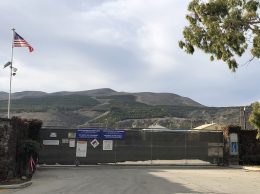Demand spikes at tri-county food banks due to COVID-19 layoffs
IN THIS ARTICLE
- Health Care & Life Science Topic
- pacbiztimes Author
By pacbiztimes Friday, April 3rd, 2020
In the past month, the FoodBank of Santa Barbara County has quadrupled the amount of food it’s distributing to members of the community.
Even still, families will line up hours in advance for food distribution, and supplies will be gone within 15 minutes of the first box being passed out.
“The scale is different than anything we’ve ever seen before,” said Judith Smith-Meyer, FoodBank SBC’s marketing communications manager.
The drastic increase in need has been brought on by steep job losses, reduced hours and furloughs across the board due to the coronavirus pandemic, and FoodBank has been stepping up to be there for residents in need. The nonprofit has done 2,000 home deliveries in the past few weeks, and is looking at increasing to 3,000-4,000 deliveries within the month.
Allan Hancock College in Santa Maria has begun distributing food on Tuesdays and Thursdays at locations on campus.
Other counties have also stepped up to help people who can’t leave their homes get food during this time.
San Luis Obispo County announced April 1 that it had made more than 700 food and 10 prescription deliveries, and that the food and prescription delivery service the county is running has served more than 900 community members. Those food deliveries were made possible through the SLO County FoodBank.
Food Share Ventura County has also ramped up, starting drive-through pop-up pantries in Oxnard, Thousand Oaks, Ventura, Ojai, Santa Paula and Camarillo.
For companies like The Berry Man, which has also started offering food pickups and home deliveries, the method is a way to both keep people working and help the community. The Berry Man, based in Santa Barbara, has had to furlough or massively reduce the hours of most employees, and this keeps the company a little busier during a time when most of its core customers — restaurants — are closed or serving a significantly-smaller volume of food.
“(Home deliveries are) not really a way to make profit, nor was it intended for that,” said Les Clark, president of The Berry Man.
For FoodBank of Santa Barbara County, which previously only did limited deliveries, this is an extreme switch. Now, the no-contact food deliveries are available for anyone 60 and over, or people who are 55 and older who have disabilities.
FoodBank of SBC has also switched to drive-through food distributions at sites all over the county. Where people were previously able to go through the distribution centers and choose the food they wanted, the organization is now pre-bagging the food and placing it in the person’s car, to reduce the amount of people who come in contact with the food.
The increased need has been costly for FoodBank of SBC. Within the first week of the crisis, the nonprofit spent $100,000 on food, including $70,000 on basic grocery items, $22,000 on produce, $7,000 on eggs and $2,000 on tortillas. To store the extra food and provide more space so volunteers can social distance, the organization added two temporary warehouses to the two it already had.
Smith-Meyer said FoodBank of SBC has about 20 days of food on hand, at the rate it’s distributing, but the need is growing.
“There’s an intense increase and urgency of the need, even for the FoodBank,” Smith-Meyer said.
FoodBank of SBC is working with community partners to meet the needs as best it can. Girls Inc. donated 12 of its vans for FoodBank to use while delivering groceries, and Route4Me is donating its services to help the organization plan those routes. FoodBank is also working with community partners like the Boys & Girls Club of Santa Barbara, community centers and churches to help staff drive-through locations.
Additionally, FoodBank of SBC got a slew of early, one-time donations from restaurants who donated food they couldn’t sell.
“This is the acute version of ‘it takes a village’,” Smith-Meyer said. “It takes a virtual village, and it takes a county.”
While this hasn’t been an easy transition for the FoodBank of SBC, it is one the nonprofit was ready for. After previous major natural disasters like the Thomas fire and the Montecito mud flows rocked the community in previous years, the FoodBank of SBC made plans with the county and other charities in the region on how to respond if another disaster meant people couldn’t leave their homes to get food.
“Unfortunately, but fortunately, this is the exact reason we needed it,” Smith-Meyer said. “It’s a hard hit for the community to take, and it’s going to take a long time (to recover), but the FoodBank is well-positioned to respond.”
• Contact Amber Hair at [email protected].
Related Articles
 Friday, October 14th, 2022
Friday, October 14th, 2022











